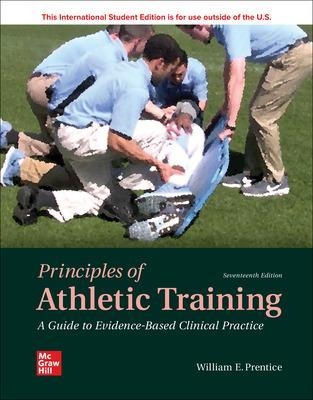
ISE Principles of Athletic Training: A Guide to Evidence-Based Clinical Practice
McGraw-Hill Education (Verlag)
978-1-260-57093-9 (ISBN)
Principles of Athletic Training: A Competency-Based Approach is designed to be used by athletic trainers in courses concerned with the scientific, evidence-based and clinical foundations of athletic training and sports medicine. The text leads the student from general foundations to specific concepts relative to injury prevention, evaluation, management, and rehabilitation. As the student progresses from beginning to end, he or she will understand the complexities of the profession of athletic training. An over-arching goal of the text is to make certain that each and every one of the educational competencies identified by the Education Council is specifically covered. After using this text the student should be able to apply the appropriate techniques and concepts in the day-to-day performance of his or her job as an athletic trainer.
McGraw-Hill Connect® is a subscription-based learning service accessible online through your personal computer or tablet. Choose this option if your instructor will require Connect to be used in the course. Your subscription to Connect includes the following:
• SmartBook® - an adaptive digital version of the course textbook that personalizes your reading experience based on how well you are learning the content.
• Access to your instructor’s homework assignments, quizzes, syllabus, notes, reminders, and other important files for the course.
• Progress dashboards that quickly show how you are performing on your assignments and tips for improvement.
• The option to purchase (for a small fee) a print version of the book. This binder-ready, loose-leaf version includes free shipping.
Complete system requirements to use Connect can be found here: http://www.mheducation.com/highered/platforms/connect/training-support-students.html
Dr. William Prentice is Professor of Exercise and Sport Science and Coordinator of the Sports Medicine Program at the University of North Carolina at Chapel Hill, where he also serves as the Director of the NATA approved Graduate Athletic Training Education Program. He received his BS and MS from the University of Delaware and his Ph.D. in Sports Medicine and Applied Physiology from the University of Virginia. He also has a BS in Physical Therapy from the University of North Carolina. He is a Certified Member of the National Athletic Trainers' Association and has received the Sayers A. "Bud" Miller Distinguished Athletic Trainer Educator Award and the Most Distinguished Athletic Trainer Award from the NATA. In 2004 he was inducted into the NATA Hall of Fame. Dr. Prentice served as the Athletic Trainer for the Women's Soccer Program, which has won eighteen NCAA National Championships. He teaches graduate courses in sports medicine and athletic training. Dr. Prentice is the author of nine best-selling texts in athletic training, sports medicine, and health-related fitness.
PART I: Professional Development and Responsibilities Chapter 1: The Athletic Trainer as a Health Care Provider Historical PerspectivesSports Medicine and Athletic TrainingEmployment Settings for the Athletic TrainerRoles and Responsibilities of the Athletic TrainerReferring the Patient to Other Medical and Nonmedical Support Services and Personnel Recognition and Accreditation of the Athletic Trainer as an Allied Health ProfessionalRequirements for Certification as an Athletic TrainerState Regulation of the Athletic TrainerFuture Directions for the Athletic TrainerSummaryWebsitesChapter 2: Health Care Organization and Administration in Athletic TrainingEstablishing a System for Athletic Training Health CareIssues Specific to Athletic Training Program Operation in the Secondary-School, College, or University SettingIssues Specific to Athletic Training Program Operation in the Clinic, Hospital, Corporate, or Industrial SettingRecord KeepingThe Computer as a Tool for the Athletic TrainerCollecting Injury DataSummary Chapter 3: Legal Concerns and Insurance IssuesLegal Concerns for the Athletic TrainerInsurance ConsiderationsThird-Party ReimbursementSummaryWebsitesPART II: Risk ManagementChapter 4: Fitness and Conditioning TechniquesThe Relationship between Athletic Trainers and Strength and Conditioning CoachesPrinciples of ConditioningWarm-Up and CooldownCardiorespiratory EnduranceThe Importance of Muscular Strength, Endurance, and PowerImproving and Maintaining FlexibilityFitness AssessmentPeriodization in ConditioningSummaryWebsitesChapter 5: Nutrition and Supplements Nutrition BasicsEnergy SourcesRegulator NutrientsNutrient Requirements and RecommendationsDietary SupplementsEating and Drinking PracticesGlycogen SupercompensationBody Composition and Weight Control Summary WebsitesChapter 6: Environmental Considerations Hyperthermia HypothermiaAltitudeOverexposure to SunLightning SafetyAir PollutionCircadian Dysrhythmia (Jet Lag)Synthetic TurfSummaryWebsitesChapter 7: Protective Equipment Safety Standards for Sports Equipment and FacilitiesLegal Concerns in Using Protective EquipmentEquipment Reconditioning and RecertificationUsing Off-the-Shelf versus Custom Protective EquipmentHead ProtectionFace ProtectionNeck ProtectionTrunk and Thorax ProtectionLower-Extremity Protective EquipmentElbow, Wrist, and Hand ProtectionConstruction of Protective and Supportive DevicesSummaryWebsitesChapter 8: Wrapping and TapingWrappingNonelastic and Elastic Adhesive TapingCommon Taping ProceduresKinesio TapingSummaryWebsitesPART III: Pathology of Sports InjuryChapter 9: Mechanisms and Characteristics of Musculoskeletal and Nerve TraumaMechanical InjuryMusculotendinous Unit InjuriesSynovial Joint InjuriesBone InjuriesNerve TraumaBody Mechanics and Injury SusceptibilitySummaryWebsitesChapter 10: Tissue Response to InjuryThe Healing ProcessSoft-Tissue HealingBone HealingPainSummaryWebsitesPART IV: Management SkillsChapter 11: Psychosocial Intervention for Sports Injuries and IllnessesThe Psychological Response to InjuryThe Athlete and the Sociological Response to InjuryPredictors of InjuryReacting to Athletes with InjuriesPsychological Factors in the Rehabilitation ProcessMental Training TechniquesMental DisordersSummaryWebsitesChapter 12: On-the-Field Acute Care and Emergency ProceduresThe Emergency Action PlanPrinciples of On-the-Field Injury AssessmentThe Primary SurveyThe Secondary Survey Moving and Transporting the Injured PatientEmergency Emotional CareProper Fit and Use of the Crutch or CaneSummaryWebsitesChapter 13: Off-the-Field Injury EvaluationClinical Evaluation and DiagnosisBasic Knowledge RequirementsProgress EvaluationsDocumenting Injury Evaluation InformationSOAP NotesAdditional Diagnostic Tests Used by a PhysicianErgonomic Risk AssessmentSummaryWebsitesChapter 14: Infectious Diseases, Bloodborne Pathogens, and Universal PrecautionsInfectious DiseasesBloodborne PathogensUniversal Precautions in an Athletic EnvironmentSummaryWebsitesChapter 15: Using Therapeutic ModalitiesLegal ConcernsClassification of Therapeutic ModalitiesThermal Conductive Energy ModalitiesAcoustic ModalitiesMechanical ModalitiesModalities Not Commonly Used by Athletic TrainersRecording Therapeutic Modality TreatmentsSafety in Using Therapeutic ModalitiesEvidence-Based Data Regarding Therapeutic Modality UseSummaryWebsitesChapter 16: Using Therapeutic Exercise in RehabilitationThe Athletic Trainer’s Approach to RehabilitationTherapeutic Exercise versus Conditioning ExerciseSudden Physical Inactivity and Injury ImmobilizationMajor Components of a Rehabilitation ProgramDeveloping a Rehabilitation Plan Additional Approaches to Therapeutic Exercise in RehabilitationPurchasing and Maintaining Therapeutic Exercise EquipmentSummaryWebsitesChapter 17: Pharmacology, Drugs, and SportsWhat is a Drug?PharmacokineticsLegal Concerns in Administering versus Dispensing DrugsSelected Therapeutic DrugsDrugs that can Increase the Rate of Heat IllnessProtocols for Using Over-the-Counter MedicationsSubstance Abuse Among AthletesDrug Testing in AthletesSummaryWebsitesPART V: Musculoskeletal ConditionsChapter 18: The Foot Foot AnatomyFunctional Anatomy and Foot BiomechanicsPrevention of Foot InjuriesFoot AssessmentRecognition and Management of SpecificInjuriesFoot RehabilitationSummaryWebsitesChapter 19: The Ankle and Lower Leg Anatomy of the Lower Leg and AnkleFunctional AnatomyPreventing Injury to the Lower Leg and AnkleAssessing the Lower Leg and AnkleRecognition of Specific InjuriesRehabilitation Techniques for the Lower Leg and AnkleSummaryWebsitesChapter 20: The Knee and Related StructuresAnatomy of the Lower Leg and AnkleFunctional AnatomyPreventing Injury to the Lower Leg and AnkleAssessing the Lower Leg and AnkleRecognition of Specific InjuriesRehabilitation Techniques for the Lower Leg and AnkleSummaryWebsitesChapter 21: The Thigh, Hip, Groin, and PelvisAnatomy of the ThighFunctional Anatomy of the ThighAssessment of the ThighPrevention of Injuries to the Thigh, Hip, Groin, and Pelvic RegionRecognition and Management of Thigh InjuriesAnatomy of the Hip, Groin, and Pelvic RegionFunctional Anatomy of the Hip, Groin, and Pelvic RegionAssessment of the Hip, Groin, and PelvisRecognition and Management of Specific Hip, Groin, and Pelvic InjuriesThigh and Hip Rehabilitation TechniquesSummaryWebsitesChapter 22: The Shoulder ComplexAnatomy of the ShoulderFunctional AnatomyPrevention of Shoulder Injuries Assessment of the Shoulder ComplexRecognition and Management of Specific InjuriesThrowing MechanicsRehabilitation of the Shoulder ComplexSummaryWebsitesChapter 23: The ElbowAnatomy of the Elbow JointFunctional AnatomyAssessment of the ElbowRecognition and Management of Injuries to the ElbowRehabilitation of the ElbowSummaryWebsitesChapter 24: The Forearm, Wrist, Hand, and FingersAnatomy of the ForearmAssessment of the ForearmRecognition and Management of Injuries to the ForearmAnatomy of the Wrist, Hand, and FingersAssessment of the Wrist, Hand, and FingersRecognition and Management of Injuries to the Wrist, Hand, and FingersRehabilitation of Injuries to the Forearm, Wrist, Hand, and FingersSummaryWebsitesChapter 25: The SpineAnatomy of the SpineFunctional AnatomyPrevention of Injuries to the SpineAssessment of the SpineRecognition and Management of Specific Injuries and ConditionsRehabilitation Techniques for the NeckRehabilitation Techniques for the Low BackSummaryWebsites PART VI: General Medical ConditionsChapter 26: The Head, Face, Eyes, Ears, Nose, and ThroatPrevention of Injuries to the Head, Face, Eyes, Ears, Nose, and ThroatThe HeadThe Face Dental InjuriesNasal InjuriesEar InjuriesEye In
juriesThroat InjuriesSummaryWebsitesChapter 27: The Thorax and AbdomenAnatomy of the ThoraxAnatomy of the AbdomenPrevention of Injuries to the Thorax and AbdomenAssessment of the Thorax and AbdomenRecognition and Management of Specific Injuries and Conditions of the Thoracic Region Recognition and Management of Specific Injuries and Conditions of the Abdomen Injuries and Conditions Related to the Digestive System SummaryWebsitesChapter 28: Skin DisordersSkin Anatomy and FunctionSkin Lesions DefinedSkin TraumaBacterial InfectionsFungal Infections Viral InfectionsAllergic, Thermal, and Chemical Skin ReactionsInfestation and BitesOther Skin ConditionsSummaryWebsitesChapter 29: Additional General Medical ConditionsThe Role of the Immune SystemViral InfectionsRespiratory ConditionsMuscular System DisordersNervous System DisordersBlood and Lymph DisordersEndocrine System DisordersSeizure DisordersHypertension (High Blood Pressure)CancerSexually Transmitted Diseases (STDs)Menstrual Irregularities and the Female Reproductive SystemSummary WebsitesAppendix A: Addresses of Professional Sports Medicine OrganizationsAppendix B: NATA Position, Official, Consensus, and Support StatementsAppendix C: Sports Medicine–Related JournalsAppendix D: Sample ResumeAppendix E: NATA Code of EthicsAppendix F: Manual Muscle TestsAppendix G: Goniometric Measurements of Range of Motion
| Erscheinungsdatum | 29.04.2020 |
|---|---|
| Zusatzinfo | 221 Illustrations |
| Verlagsort | OH |
| Sprache | englisch |
| Maße | 257 x 2304 mm |
| Gewicht | 1964 g |
| Themenwelt | Medizin / Pharmazie ► Medizinische Fachgebiete ► Sportmedizin |
| Wirtschaft ► Betriebswirtschaft / Management | |
| ISBN-10 | 1-260-57093-2 / 1260570932 |
| ISBN-13 | 978-1-260-57093-9 / 9781260570939 |
| Zustand | Neuware |
| Haben Sie eine Frage zum Produkt? |
aus dem Bereich


